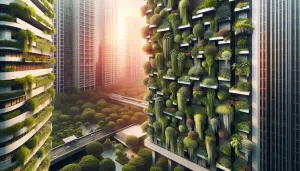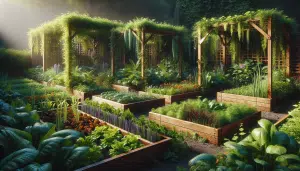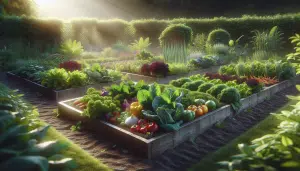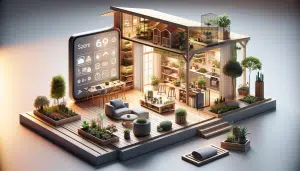Create Your Dream Pollinator Garden at Home
Lily Carter September 24, 2025
Discover the surprising benefits and easy steps to designing a pollinator garden for your home. This in-depth guide covers native plant selection, garden planning tips, and sustainable care to support bees, butterflies, and biodiversity right outside your door.
Understanding Why Pollinator Gardens Matter
Pollinator gardens have surged in popularity as homeowners realize the important role these diverse spaces play in supporting local wildlife. By dedicating even a small patch of your yard to native flowers and host plants, you create a vital safe haven for bees, butterflies, moths, birds, and beneficial insects. These pollinators are responsible for the fruits, vegetables, and flowers that bring beauty and nutrition into every home and community. Without intentional habitat, their populations face ongoing decline, making residential pollinator gardens a powerful tool in ecological restoration.
Research shows that home landscapes planted with diverse, pesticide-free blooms can significantly boost pollinator abundance and diversity. Not only do these gardens supply food resources through nectar and pollen, but they also offer places for insects to lay eggs, overwinter, and shelter from predators. For homeowners, cultivating such environments can be a deeply rewarding way to engage with nature. It brings an ever-changing array of color, motion, and life to your personal outdoor space. Observers often find renewed joy watching butterflies float by or hearing the gentle buzz of visiting bees.
Beyond helping pollinators, gardens designed with purpose support soil health, reduce erosion, and even boost local fruit and vegetable yields. The presence of pollinators means more blooms and larger harvests, all without relying on chemical interventions. Importantly, these benefits ripple outward, connecting your yard to a larger network of green spaces and restoring fragmented habitats in cities and suburbs. Choosing to start a pollinator garden can be a simple step toward meaningful environmental impact at home.
Key Principles of Pollinator-Friendly Landscaping
Designing a successful pollinator garden requires more than simply planting a few flowers. It starts with understanding the needs of native bees, butterflies, and other pollinating species in your area. Focusing on layers of structure—combining trees, shrubs, perennials, and groundcovers—creates continuous food and habitat sources. Including clusters of the same plant species helps pollinators easily locate and access resources, making your garden both functional and visually appealing. Diversity is crucial, as different species prefer specific colors, shapes, and bloom times.
Pesticide reduction or elimination is another core principle. Many common lawn and garden chemicals are harmful to insects, even in small quantities. Opting for organic gardening strategies and integrated pest management protects beneficial bugs. Timing matters, too: include native flowering plants that bloom from early spring through late fall to provide consistent nectar and pollen. Water sources, like shallow birdbaths or pebble-lined dishes, complete the habitat and attract thirsty visitors.
It’s also important to avoid excessive tidying in fall. Leaving seed heads, hollow stems, and leaf litter creates nesting and overwintering spots. Such small changes make a big difference for resident pollinators. Adopting these simple practices will transform your outdoor space into a vibrant, living ecosystem that supports wildlife and rewards you with year-round beauty and activity.
Choosing the Best Native Plants for Your Garden
Native plants are the backbone of an effective pollinator garden. These adapted species provide the specific pollen, nectar, and host resources local pollinators depend on. Selecting a mix of native wildflowers, flowering shrubs, and trees ensures a continuous display across the growing season. Options might include purple coneflower, bee balm, milkweed, black-eyed Susan, and lupine, depending on your region. Consulting your extension service or a local native plant society can help identify the perfect combination for your location.
Groupings of three or more individuals from the same plant species create eye-catching splashes of color and make it easier for pollinators to find flowers. Avoid double-flowered varieties, as they often produce less nectar. Consider adding larval host plants for critical butterfly species—milkweed for monarchs or parsley for swallowtails, for example. These additions invite not just foraging adults, but also their caterpillars, supporting the entire pollinator life cycle.
Remember, selecting at least one plant from each major blooming period—spring, summer, and fall—ensures food is always available. Some trees, like serviceberry or redbud, provide early-season nourishment. Fall asters and goldenrods support late migrants. With careful plant choices, your garden becomes an all-season resource hub. Native plant selections also require less maintenance, as they’re adapted to local climate and soils, making sustainable gardening even easier.
Design and Layout Tips for Lasting Pollinator Appeal
The layout of a pollinator garden influences both visual enjoyment and wildlife effectiveness. Clustering flowers by color and type allows bees and butterflies to feed efficiently, naturally encouraging longer visits and more pollination. Include tall and short plants together. Place taller species at the back or center, with low-growing species at the front or edges. This layered design mimics natural meadows and maximizes both sunlight and habitat for different pollinator species.
Pathways—whether formal or winding—invite human visitors to explore without compacting soil or trampling plants. Use mulch or ground covers to suppress weeds and retain moisture. Integrate garden features such as rocks, logs, or brush piles to offer additional shelter and basking spots for insects and small wildlife. Including a few sun-exposed, bare areas provides nesting habitat for ground-nesting native bees. Overall, strive to balance structure with openness, ensuring easy access for both people and pollinators.
Consider creating dedicated “pockets” or sections for different pollinator groups. Some gardeners reserve spaces for spring ephemerals that bloom before tree leaves emerge, while others focus on milkweed beds for monarch butterflies. Regularly refresh your garden design by adding new natives or adjusting layouts as plants mature and spread. Over time, your pollinator garden becomes a resilient and beautiful ecosystem, teeming with life in every season.
Sustainable Care and Maintenance Made Simple
A pollinator garden often requires less maintenance than a traditional lawn, but a few care practices help maximize its value. Regular watering is critical during establishment, but once natives are rooted, many tolerate drought and only need supplemental water in extreme conditions. Avoid synthetic fertilizers, as most native plants thrive in modest or poor soils. Instead, top-dress with compost or leaf mold to gradually enrich organic matter.
Rather than clearing away dead grass, stalks, and leaves each fall, leave them in place to support overwintering insects. In spring, delay clean-up until temperatures reach about 50°F (10°C) to give bees and butterflies a chance to emerge. Spot-weed by hand and use mulch for weed suppression, avoiding herbicides that may harm pollinators. With minimal intervention, a resilient mix of plants will out-compete weeds, maintaining garden health and structure over time.
If pests arise, encourage beneficial insects—such as lady beetles or lacewings—by offering habitat or adding compatible plants. These allies keep harmful bugs in check without toxic sprays. Over time, a thriving pollinator garden often becomes self-sustaining. The rewards are visible in every buzzing bee, fluttering butterfly, and robust bloom. Consistent, gentle stewardship ensures your garden continues to grow more diverse and beautiful year after year.
The Broader Impact of Home Pollinator Gardens
When homeowners choose to support pollinators on their own land, the benefits extend far beyond individual yards. Each garden adds to a growing patchwork of habitat across neighborhoods and cities. Collectively, these linked spaces are critical for pollinator movement, reproduction, and survival, especially in highly developed regions. Such efforts also inspire neighbors, friends, and local schools to get involved, magnifying the positive impact for both people and wildlife.
Recent studies highlight that increased urban pollinator habitat leads to improved crop yields even miles away from planted areas. This is because pollinators, especially bees, can travel considerable distances, carrying pollen between gardens, parks, and even nearby farms. In this interconnected web, one person’s efforts to grow more flowers may result in stronger food systems and greater ecosystem resilience at the community level.
In addition to ecological benefits, home pollinator gardens support educational opportunities and mental health. Observing the daily drama of visiting insects encourages curiosity, patience, and scientific learning. Gardeners often describe feeling more connected to their surroundings and less stressed after spending time among thriving plants and wildlife. In this way, the simple act of planting for pollinators refuels people as much as it does local biodiversity.
References
1. Xerces Society for Invertebrate Conservation. (n.d.). Gardening for Pollinators. Retrieved from https://xerces.org/pollinator-conservation/gardening-for-pollinators
2. The U.S. Fish & Wildlife Service. (n.d.). Pollinators: How You Can Help. Retrieved from https://www.fws.gov/pollinators/pollinatorpages/yourhelp.html
3. The National Wildlife Federation. (n.d.). How to Create a Pollinator Garden. Retrieved from https://www.nwf.org/Garden-for-Wildlife/Create/At-Home/Pollinator-Garden
4. USDA Forest Service. (n.d.). Gardening for Pollinators. Retrieved from https://www.fs.usda.gov/wildflowers/pollinators/gardening.shtml
5. Penn State Extension. (n.d.). Pollinator-Friendly Gardens. Retrieved from https://extension.psu.edu/pollinator-friendly-gardening
6. Lady Bird Johnson Wildflower Center. (n.d.). Pollinator Gardening. Retrieved from https://www.wildflower.org/learn/how-to/pollinator-gardening







